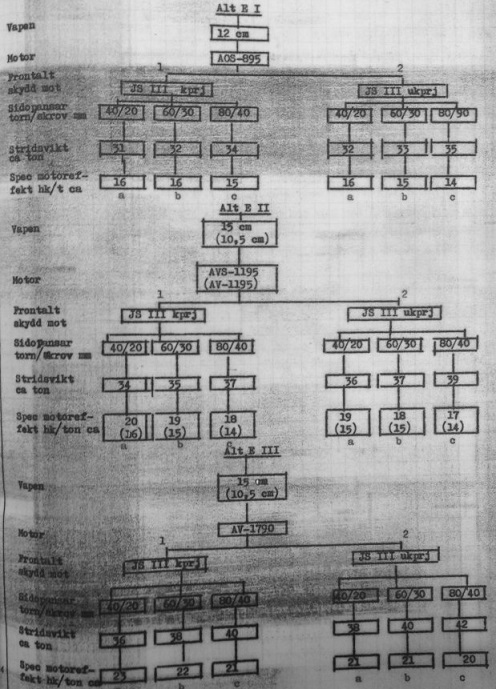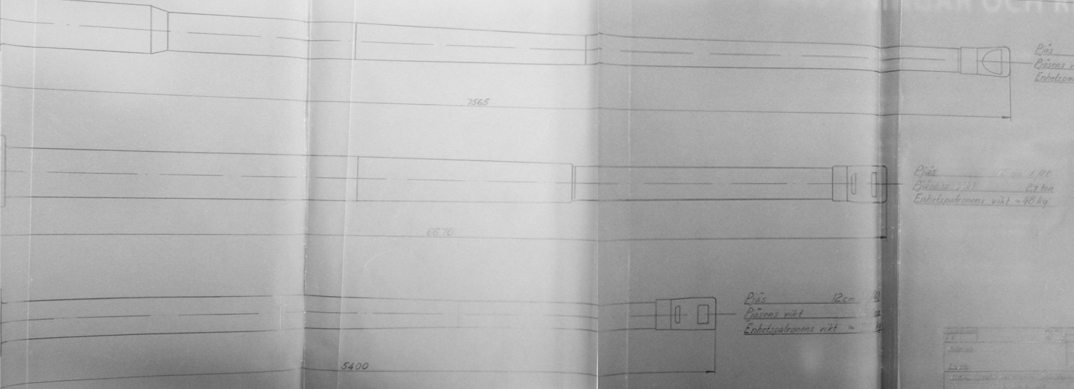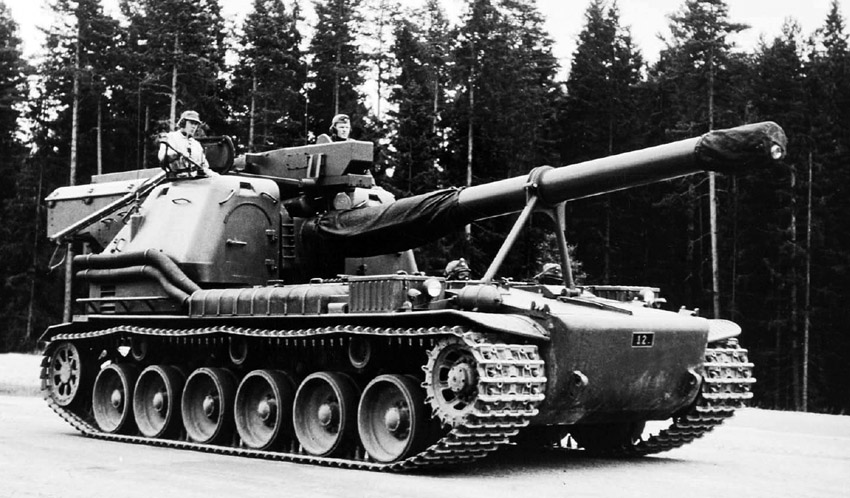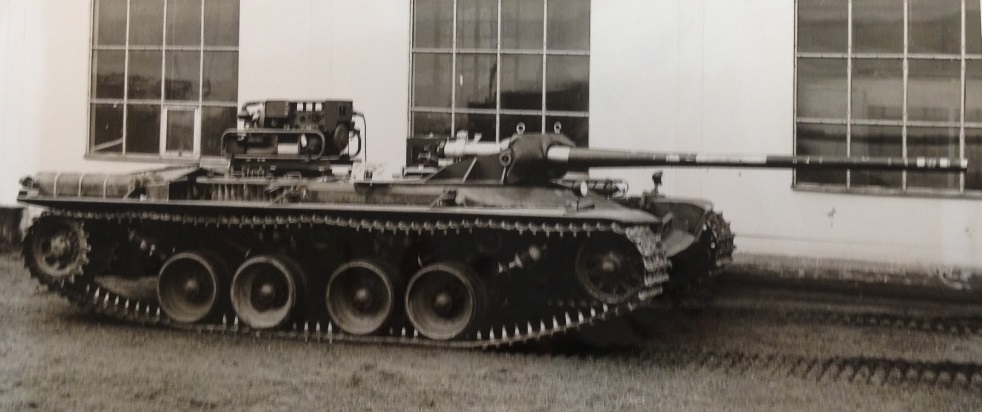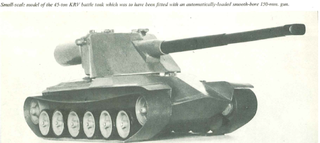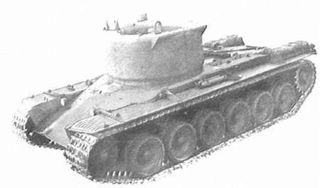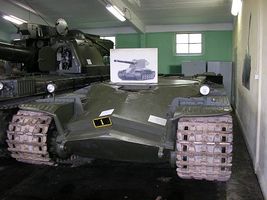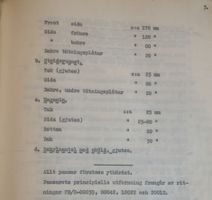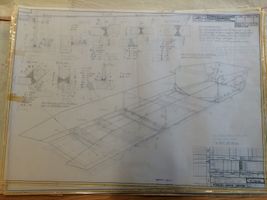Kranvagn
| |
This article requires additional modification. The design and/or content of this article do not conform to wiki standards.
|
Kranvagn
Mouse over "
[Client Values; Actual values in
| 6,100,000 |
| 2000400 HP Hit Points |
| 44.8/4827.4/48 t Weight Limit |
- Commander (Radio Operator, Loader)
- Driver
- Gunner (Loader)
| 810810 hp Engine Power |
| 45/12 km/h Speed Limit |
| 3030 deg/s Traverse |
| 18.0829.56 hp/t Power/Wt Ratio |
| NoNo Pivot |
| // mm Hull Armor |
| 225/70/37225/70/37 mm Turret Armor |
APCR/HEAT/HE
APCR/HEAT/HE Shells |
1015/4800/870
1015/4800/870 Shell Cost |
| 440/440/530440/440/530 HP Damage |
| 252/300/60252/300/60 mm Penetration |
|
5.91 r/m ▲
5.91 r/m Magazine-fed Gun ▲ Rate of Fire Magazine-fed Gun |
|
3018.4 ▲
Magazine-fed Gun
▼
Magazine-fed Gun
▲
3018.4 Magazine-fed Gun ▲
Magazine-fed Gun
▼
Magazine-fed Gun
▲ Damage Per Minute Magazine-fed Gun |
|
0.4 m ▲
0.4 m With 50% Crew: 0.496 m ▲ Accuracy With 50% Crew: 0.496 m |
| 2.5 s 2.5 s Aim time |
| 2828 deg/s Turret Traverse |
| 360° Gun Arc |
| -12°/+10°-12°/+10° Elevation Arc |
| 4848 rounds Ammo Capacity |
| 1515 % Chance of Fire |
| 390 m 390 m View Range |
| 850 m 850 m Signal Range |
X
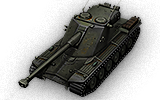
6100000
The Kranvagn is a Swedish tier 10 heavy tank.
A project for a new vehicle for the Swedish army that started in 1949. For confidentiality purposes, the vehicle was given an unusual name, KRV, which stands for self-propelled crane (in Swedish). The project was based on the French AMX 50. A lightweight chassis was built and tested; in addition, a dummy with a turret was produced. A prototype was never built.
The final advancement of the Swedish turreted tank line. Shared with its predecessors; thanks to the size, weight and power to weight ratio, it's considered by many to be more of a medium tank rather than a heavy tank. The aforementioned size together with a tough frontal turret and a solid gun depression plus a decent mobility means that the Kranvagn can be extremely effective in a hulldown spot. However, be careful about your position. Exposing your hull will almost always result in a penetration, since it isn't as reliable as the turret front. Also mind that, when gun depression is used, the turret rear and commander's hatch is exposed which is a weak spot. You can counter this by pointing the gun upwards.
The Kranvagn marks the end of its Swedish heavy line.
Modules / Available Equipment and Consumables
Modules
| Tier | Gun | Penetration (mm) |
Damage (HP) |
Rate of fire (rounds/minute) |
Dispersion (m/100m) |
Aiming time (s) |
Weight (kg) |
Price (
| |
|---|---|---|---|---|---|---|---|---|---|
| X | 12 cm akan L/40 | 252/300/60 | 440/440/530 | 5.91 | 0.4 | 2.5 | 1600 | 320000 |
| Tier | Engine | Engine Power (hp) |
Chance of Fire on Impact (%) |
Weight (kg) |
Price (
| |
|---|---|---|---|---|---|---|
| X | SFA F12 | 810 | 15 | 1475 | 105000 |
| Tier | Suspension | Load Limit (т) |
Traverse Speed (gr/sec) |
Rmin | Weight (kg) |
Price (
| |
|---|---|---|---|---|---|---|---|
| X | Kranvagn | 48 | 30 | B/2 | 9000 | 82500 |
Compatible Equipment
Compatible Consumables
Player Opinion
Pros and Cons
Pros:
- Amazing turret armor: when hulldown, the turret will reliably bounce the HEAT shells of a Jagdpanzer E100!
- 2nd best gun depression in its entire tier which can make the turret even harder to penetrate
- Low silhouette and small size for heavy tank; especially compared to AMX 50 B
- Second highest top speed for Heavy Tanks (60KM/H)
- Decent accuracy and gun handling, especially compared to its predecessor
- Trollish upper and turret plate can create ricochets
Cons:
- Lowest HP of all tier 10 heavies (2000 HP)
- Overall mediocre hull armor, the upper plate is unreliable and very weak aside from autobounce angles
- Mediocre in-clip reload
- Contrasting with its amazing gun depression, it has one of the worst gun elevation in the game (only 10 degrees); will have a problem shooting enemies standing on the high ground
- Fairly frequent module damage; driver dies very often and ammorack damage is frequent
- Relatively sluggish acceleration; reaches its top speed only when going downhill
- Premium ammo has very low penetration for tier 10 HEAT shell; standard APCR has much worse shell velocity than most APCR
- Very vulnerable to artillery due to its playstyle, low health and thin hull armor
Performance
The Kranvagn handles much like its predecessors only with slightly better gun-handling (decent dispersion @.36 for a tier 10 heavy-tank), drum reload-time, and even a stronger turret armor than the Emil II while still maintaining the 12 degrees of gun depression. The Kranvagn excels at mid-range combat and is best suited in hull-down positions where the hull is protected and the turret is the only part exposed. The turret is extremely strong, and can easily bounce Hi-caliber AP/APCR shells such as the JPZ-E100. This tank has the potential of being an absolute terror against anything unfortunate enough to be caught in the Kranvagn's gun range.
Unfortunately for the Kranvagn, it suffers from an extremely weak and unreliable hull-armor (its armor is only slightly better than the Leopard 1). It is imperative that the player be aware of the hull exposure while being focused at anytime to maximize survival; this tank is not good for brawling. While it doesn't often get ammo racked, it does catch fire fairly easy if shot in the rear. It should also be noted, that the side of the turret and cupolas are also vulnerable if they are exposed to enemy fire; Kranvagn drivers should keep this in mind while attempting to progress forward. The tank's mobility is average, as its ground resistances are very high so acceleration is a bit sluggish and traverse is 30 deg/s; the tank is still mobile enough to get around and re-position wherever needed.
This tank should be played as a support / frontline (on ridges where available). Fighting alone can lead to trouble quickly with this tank, so be cautious. Also Kranvagn players must be aware of artillery as they will punish the tank if it stays in the focus for too long. HE and HESH shells from Hi-caliber Tank-Destroyers such as the FV215B (183) can also inflict significant module damage even against the turret.
Suggested Equipment
Gallery
Historical Info
The EMIL project started out in 1951 as more of a medium tank, but in 1952, the army, like other western nations, decided that they needed something to counter the Soviet IS-3 heavy tank and it was this line of thought, that would above all else shape the EMIL project after 1951.
The main inspiration for the design seems to have been drawn, initially at least, from the French and German tank designs – more specifically from the new AMX 13, which had recently been tested in Sweden, as well as the German Panther. The influence of these tanks can be seen in the addition of a French style oscillating turret with an autoloader and the well-sloped frontal glacis. But in 1952, as the design was being reworked, it was decided to borrow the Soviet idea of the pike nose in order to increase the effective thickness even further.
Although all were based around the same principles, there were several different variants of the EMIL, specificially there were three main ones. First was the E1, which was to correspond with the 1951 proposal, but with the new pike nose front and with an American tank engine instead of a Swedish one. The second design was called E2 and was a sort of a middle range model, which would be heavier than the E1, but also would be able to carry a 15cm smoothbore instead of the 12cm rifled gun, planned for the earlier models. The E2 was also able to sport a bigger engine and this design was considered as the most realistic one, since there was no guarantee that a bigger engine could be acquired. Last was the E3, which was the top range model with a weight of over 40 tons and an American 810hp engine, this was at the time seen as a bit too heavy and unrealistic, but as the engine became available, this design was chosen and two hulls were built in 1955.
A chart with various models
Some of the other variables that separated the designs included front and side armor for the hull and turret, engine output, main armament and suspension. In the case of frontal armor, there was a choice of either having a 120mm hull and 140mm turret armor or 145mm hull and 170mm turret armor, these thicknesses were specifically chosen to be able to withstand a frontal hit from the IS-3 heavy tank with either (in the first case) regular AP ammo or (in the latter) subcaliber ammo. Side armor was divided into 3 options: first was a 20mm hull and 40mm turret, 2nd was a 30mm hull and 60mm turret and third was a 40mm hull and 80mm turret. The rest of the armor was common to all variants of the tank. This included the hull roof, driver’s port (middle front glacis) and floor. The rear armor was 30mm for all the variants except for the one with 40mm side armor, where the rear was also 40mm thick.
One of the most important variables was the engine output. As mentioned before, the engines considered were American tank engines, mainly from Continental. These included the AOS-195 (500hp), AV-1195 (540hp), AVS-1195 (665-668hp) and AV-1790 (810hp) models. Initially, it was thought that the acquisition of the more powerful engines wouldn’t be possible and therefore initial projections favored a middle range tank model in both weight and armor, but as negotiations continued, an example of the 810hp was acquired and considered for licensed production at SFA (the Swedish aircraft engine company). This meant that there were no longer any problems with the engine output for the tank and that the development of the top range model could be pursued. However, as the development of the tank continued, it was decided to use a Swedish engine instead, as one of sufficient power had been developed at SFA. The new engine was very powerful at around 900hp, but the power required to run the cooling system meant that when it was finally tested on the prototypes in 1955, it could only deliver 723hp with the rest being used up by the cooling system itself.
Even before 1951, studies had been made regarding the armament of what would become the EMIL project. These studies had concluded that the best armament for a future tank project would be a high caliber gun (12cm or higher) in order to effectively use HEAT shells. But these were no regular HEAT shells – in fact the Swedish idea was to mix the properties of APDS and HEAT to create a heat shell with a discarding sabot. This would allow the shell to travel much faster than a normal HEAT shell. Ultimately, the development of these munitions would prove impossible for Sweden and would be a major reason behind the cancellation of the project. The actual gun considered to use this kind of shell was at first a 12cm L/40 rifled gun and later a 15cm L/40 smoothbore gun. Besides the HEAT shells, these guns were to fire mainly HE, although there were plans for APDS ammunition as well. There were also plans for a 10,5cm gun in case the development of the previously mentioned guns would prove too complicated. One thing of note is that the 150mm gun is not viable for World of Tanks, as it is a smoothbore.
Drawing comparing the different gun options
Suspension was another thing that varied quite a bit between the different designs. We know that there were plans for up to 8 roadwheels per side, but the final prototypes ended up with 6 per side.
I should state however that some changes were made to the EMIL project after the completion of the prototypes in 1955. The main change was to the turret armor which was changed from the planned 170/80/40 to 170/70/30 in order to stabilize the gun better, elevation also changed from +8/-12 to +10/-12. Other than that, there were plans to potentially mount a British or French gun on the vehicle in 1958 after the development of a suitable Swedish one had failed.
So to summarize, the Emil was to be a heavily armored but mobile tank with a weight of under 50 tons and a 10,5-15cm gun, capable of dealing with the IS-3 at long range. So you might be thinking, why was it that this tank never entered production? Well, initially the idea was that this tank would replace the WW2 vintage Strv m/42, but the gap between the two tanks would mean that Sweden would be without a modern tank during most of the 1950′s, until a production version of the EMIL was ready. What happened instead was that Sweden purchased the British Centurion tank as a stopgap measure and with the development of the L7 gun in the late 50′, there was no longer a need for the EMIL project. However, some work continued on the prototype chassis which had been named “Kranvagn” (crane vehicle) to confuse any potential spy.
Akv 151 prototype SPG
Work on a new 15cm autoloading SPG had been in progress since before the EMIL project and a version based on the EMIL hull had been in the work since the start of the project. After the initial testing in 1955-1956, it was decided that one of the prototype hulls would be converted to this SPG configuration. This vehicle prototype was built in 1960 and would eventually become the Bkan 1, but that is a story for another time
There was also an idea to mount the Centurion Mk.10 turret on the Krv chassis in order to create a competitor to the Centurion Mk.10, but in the end, the Swedish army decided that it would be simpler if they just purchased the whole Centurion Mk.10 instead. However there were also plans to let a vehicle in this configuration serve as a prototype for future turreted tank concepts in Sweden, but nothing ever came of this. Instead, the remaining prototype had 4 of its roadwheels removed and was fitted with equipment for testing of the hydraulic suspension as well as a fixed 20pdr gun and was used as a test rig for the S-tank. This prototype chassis still exist in the Arsenalen museum, although it’s currently in storage and not on display.
Interpretation of the Centurion/Kranvagn hybrid
Kranvagn chassis during suspension testing for the S tank project
Last time the Krv chassis was seen by the public was its move to the new Arsenalen museeum storage
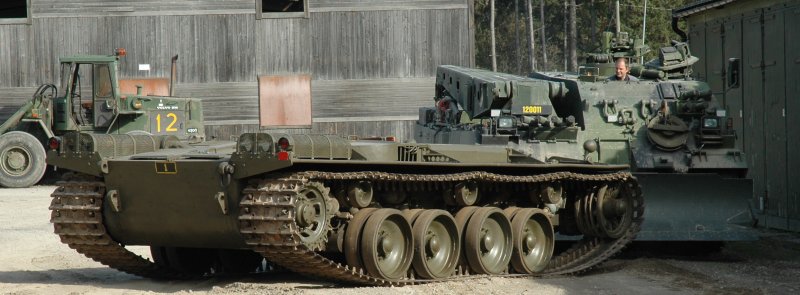
Historical Gallery
Historical Accuracy Errata
* The armor of in-game Kranvagn greatly differs from historical one:
- The frontal hull armor is decreased from the historical 95mm of the upper glacis and the 145mm of the lower glacis to the in game 90 mm of the upper glacis and the 115 mm of the lower glacis.
- The hull side armor is increased from the historical 37mm to the in game 70mm.
- The turret front was increased from the historical 170mm to the in game 225mm.
- One of its proposed armaments, a 150mm smoothbore gun, is missing.
- Weight of the vehicle is heavier by 3ton compared to what is documented
- Engine power is 23hp less then historically recorded
- With documented weight of 41.8t and 723hp engine the power to weight is 17.29hp/t
Sources and External Links
| Light Tanks | IStrv fm/21 • IIStrv m/38 • IIL-60 • IIIStrv m/40L • IIILago M38 |
| Medium Tanks | IVLago • VStrv m/42 • VIStrv m/42-57 Alt A.2 • VIStrv 74 • VIILeo • VIIIStrv 81 • VIIIPrimo Victoria • VIIILansen C • VIIIUDES 14 Alt 5 • IXUDES 16 • XUDES 15/16 |
| Heavy Tanks | VIIIEmil I • VIIIEMIL 1951 • VIIIBofors Tornvagn • IXEmil II • IXStrv K • XKranvagn |
| Tank Destroyers | IIPvlvv fm/42 • IIIIkv 72 • IVSav m/43 • VIkv 103 • VIIkv 65 Alt II • VIIIkv 90 Typ B • VIIIUDES 03 • VIIIStrv S1 • IXStrv 103-0 • XStrv 103B |
| Self-Propelled Artillery |
















